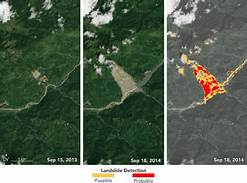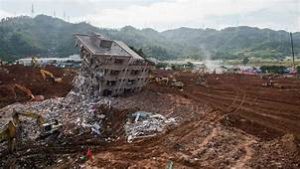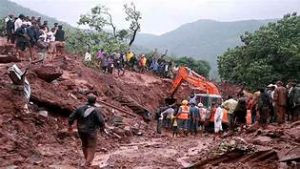If you live in a mountainous area, you are probably aware of the danger of landslides. Around the world, thousands of people die each year as a result of them. Most of these landslide casualties are caused when people are caught in the rockfall, debris flows, or volcanic debris flows. With a solid background of landslide knowledge, you can be more prepared and less likely to find yourself in a dangerous landslide disaster.
What Are Landslides?

Landslide Definitions
The term “landslide” covers an array of disasters including rockfalls, mudflows, debris flows, and slope failures. Technically, a landslide is any mass movement of material down a slope under the influence of gravity. They can move quickly or slowly, and they are most prevalent in areas that have already been subject to severe weather (heavy rain or snow, forest fires, earthquakes, etc.).
There are five primary types of landslides, each type with its own definition and primary method of movement:
- Fall
- Topple
- Slide
- Spread
- Flow
Material (rock and debris) falls from a cliff or slope
The slope itself rotates underneath material on top of the slope, causing the material to topple and rotate forward and down the slope
Material moves down the slope in a forward-slide motion parallel to the slope
Material moves horizontally in one mass movement; ground below the moving material may collapse or fracture and add to the debris mass
Material is viscous or fluid-like in its movement
They can also consist of many materials, primarily bedrock, debris, or earth.
What Is the Cause of Landslides?
They are caused when the amount of weight or pressure high up on a slope outweighs the slope itself. It can either be that the weight of the material on the slope itself has increased (in the case of a snowmelt or heavy rain) or that the slope material itself has weakened (by an earthquake or disturbance caused by human activity).
Any or all of the following can spur a landslide: rainfall, snowmelt, water level changes due to climate, erosion, earthquakes, volcanoes, or human disruption to the environment.
Major Landslide Disasters
- 1933
- 1949
- 1962
- 1970
- 1999
- 2013
- 2014
In Sichuan, China, a landslide killed over 3,000 people, and an entire town sank into the earth.
In Tajikistan, a 7.4 magnitude earthquake led to a landslide that caused rockfalls with rocks moving as fast as 30 meters per second.
In Ranrahirca, Peru, a combination avalanche landslide flew down Huascaran Mountain and killed over 4,500 people, most of them buried in their villages by the landslide of ice and debris.
In Yungay, Peru, over 22,000 people died when avalanches and landslides caused snow and debris to overtake multiple towns. The debris (consisting of 50-100 cubic meters of water and debris) moved 16.5 kilometers.
In Vargas, Venezuela, heavy rainfall caused a severe landslide which killed over 30,000 people (nearly 10% of the town). Some homes were even swept away into the ocean by the power of the landslide.
In Kedarnath, India, a combination of a heavy monsoon season and human damage to the ecosystem caused one of the worst natural disasters in Indian history. Although there had been landslides in this area before, what happened in 2013 was unprecedented. Over 5,700 people died as a result of the debris-filled water that swept through the area.
In Oso, Washington, a landslide killed 43 people. Critics claim that there could have been more forewarning to save lives as the town had experienced a record amount of rainfall and the area was known to have had landslide activity.
Where Do Landslides Occur?
Because the definition of “landslide” is so broad and the causes are wide-ranging, they can occur almost anywhere, including underwater. However, the severity of the landslide depends on the environment. Major wide-reaching landslides have occurred in many states throughout the United States; unsurprisingly, the states with the highest risk of them are those containing major mountain ranges (Appalachian mountains, Rocky Mountains, Pacific Coast ranges, and Alaska and Hawaii mountain ranges).
How to Identify Potential Landslide Calamities?

Landslides most often occur where they have occurred before- although some causes of them are environmental and spontaneous (like an especially heavy rainfall), it is more likely that the same area in a mountain range will have frequent ones. Bases of slopes are also particularly susceptible to them as are locations at the bases or tops or steep cut or old fill slopes.
It is also possible to get a ground assessment of your property done by professionals to assess the likelihood of landslide activity in your area.
Any or all of the following may be warning signs of an impending landslide:
- Leaning poles or fences (that have previously been straight)
- New cracks or mounds in the cement pavement, streets, or foundations
- New water seepage or saturation
- Rapid uptick in streams or creeks (especially if there is added debris in the water)
- Patios and decks moving away from houses
- Dirt moving from foundations
- A significant decrease in water levels of streams and creeks
- Rumbling sounds
- Shift in household door and window frames- doors sticking or gaps appearing
- Utility lines underground break
- The landscape begins to change- small slides of earth, leaning trees, ground slopes in one direction
If you suspect a landslide is occurring, watch any nearby running water. If the water color changes or debris starts to appear in the water, it is likely that a landslide of debris is on its way. If you can hear an unusual noise (such as tree branches cracking or knocking up against each other) near the flowing water, that is also a sign of an impending landslide.
Despite the seemingly straightforward nature of landslides they are still not well understood. Scientists have started using computer simulations to try to discover the key causes of them and the most likely outcomes.
The United States Geological Survey Landslides Hazard Program has been working with scientists to develop new and better methods of identifying potential landslides. The goal is that they are able to determine the causes of major landslides in order to better predict the severity of them and get the highest number of people out of harm’s way.
How to Avoid Landslides?

The only way to avoid landslides completely is to live in a flat area where gravity will be unable to pull debris and mud down, but there are other ways to prepare for them.
If you live in an area where they are common, make a landslide evacuation plan with your family and business, and prepare an emergency evacuation kit. Keep a careful watch of landslide-prone areas around your home, looking out for heavy rainfall or other environmental situations which may lead to them. Also, watch the local news or talk to geology professionals in your area- if a season has been particularly rainy, for example, they might be able to tell you if your area is at a higher risk for landslides than usual.
Additionally, you can protect yourself and your home from landslide damage by planting ground cover around your home and by installing retaining walls. Installing flexible piping on gas and water lines will also help to avoid pipes breaking and cracking in the event of a landslide.
What to Do during a Landslide?

Do not go near any slope or areas of erosion. Contact fire, police, or public works professionals.
During a landslide, leave the affected area if at all possible. If a landslide is predicted for your area, do not go to sleep and hope it’s better in the morning; many landslide deaths occur when sleeping people’s homes are consumed or destroyed by landslide materials.
If you are able to leave the landslide affected area, be careful when driving. Landslides can often fill gulleys and culverts with water and debris, making it dangerous to drive through any water if you cannot see the bottom.
If you determine that you are unable to leave your location safely, curl up into a ball and protect your head with your arms.
What to Do after a Landslide?
If you and/or your home has been caught in a landslide, ensure the building’s stability before returning. Also, stay aware of the weather- flooding also follows on the heels of landslides (especially if the landslide was caused by heavy rain or snowmelt).
Check on family, friends, and neighbors to ensure they made it out of their homes safely in plenty of time. While there are currently few landslide home insurance options, the people are the most important.
Conclusion

Although the path of a landslide is generally smaller than that of a hurricane, tornado, or earthquake, they can be incredibly deadly because of the speed at which they sweep down the mountain or slope. Now that you have more information about the causes of landslides, know where they are most likely to occur, and what you can do to prepare yourself and your family for a landslide disaster, make that action plan and be ready for anything that mother nature throws your way!

